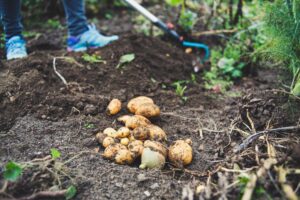Potatoes, often considered a humble yet versatile crop, play a vital role in South Africa’s agricultural landscape. With its diverse climate and rich soil, South Africa provides an ideal environment for potato cultivation. This article delves into the art of planting potatoes, exploring the best times to sow and reap this essential tuber, while also discussing the regions within South Africa where potato farming thrives.
Planting Potatoes: A Science and an Art
Choosing the Right Time
Planting potatoes in South Africa requires a delicate balance between timing and weather conditions. The ideal planting period generally falls between late winter and early spring, typically from August to September. During these months, the soil is still warm enough for proper tuber development, and the risk of frost, which can damage young plants, is minimal.
Preparing the Soil

Potatoes thrive in well-draining, loose, and slightly acidic soil. Before planting, it’s essential to prepare the soil adequately. Farmers often enrich the soil with compost or well-rotted manure, ensuring the potatoes receive a steady supply of nutrients as they grow.
Planting Techniques
Potatoes are typically planted from seed potatoes, which are small tubers saved from the previous harvest. These seed potatoes should be planted about 10-15 centimeters deep and 30-45 centimeters apart in rows. Hilling, a technique where soil is mounded around the base of the plant as it grows, helps protect the tubers from sunlight, preventing them from turning green and becoming toxic.
When to Harvest: Timing Is Everything
The anticipation of harvest time is a defining moment for potato farmers. Harvesting potatoes at the right time ensures they are at their peak flavor and nutritional value.
Signs of Readiness
Potatoes are usually ready for harvest between 90 to 120 days after planting, depending on the variety. One sign that potatoes are ready for harvest is when the plants’ foliage starts to yellow and die back. This indicates that the potatoes have reached maturity and are ready to be dug up.
Harvesting Process
Harvesting potatoes is a careful process to avoid damaging the delicate skins and bruising the tubers. Using a fork or spade, farmers gently loosen the soil around the plants, taking care not to puncture the potatoes. Once unearthed, the potatoes are left to dry on the soil surface for a few hours to toughen their skins before storage or transportation.
Potato Farming Across South African Provinces
Potato farming is a thriving industry across various provinces in South Africa, with each region contributing unique qualities to the nation’s potato production.
Western Cape: The Heart of Potato Farming
The Western Cape province, known for its Mediterranean climate and fertile soils, is a significant hub for potato farming in South Africa. The region’s cool, wet winters and warm, dry summers provide an ideal environment for potato cultivation. Farmers in the Western Cape produce a variety of potato types, from the starchy, versatile Russet to the waxy, thin-skinned Baby Potatoes, catering to diverse consumer preferences.
Free State: The Breadbasket of South Africa
Free State province is often referred to as the breadbasket of South Africa due to its extensive agricultural activities. Potatoes are a staple crop in this region, with large expanses of farmland dedicated to potato cultivation. The province’s rich, well-drained soil, combined with ample sunlight, creates optimal conditions for high-quality potato production. Free State contributes significantly to South Africa’s overall potato yield, making it a vital player in the country’s agricultural economy.

Limpopo: Embracing Diversity in Farming
Limpopo province, located in the northern part of South Africa, boasts a diverse agricultural landscape. Here, potatoes are cultivated alongside other crops, contributing to the region’s agricultural diversity. Limpopo’s warm climate and fertile soils allow for successful potato farming, with farmers embracing sustainable practices to ensure a steady supply of this essential crop. The province’s commitment to agricultural innovation positions it as a key player in South Africa’s potato industry.
Conclusion
Potatoes, with their adaptability and nutritional value, continue to be a cornerstone of South Africa’s agricultural sector. By understanding the intricacies of planting and harvesting potatoes and appreciating the regional nuances within South Africa, farmers can cultivate this humble tuber successfully. As the nation’s agricultural landscape evolves, potatoes remain a symbol of resilience, adaptability, and the agricultural expertise that defines South Africa’s farmers. Through careful cultivation and a deep understanding of the land, South Africa ensures a bountiful harvest of this versatile and essential crop, sustaining both its people and its economy for generations to come
Written by: Nicolene Oosthuizen

